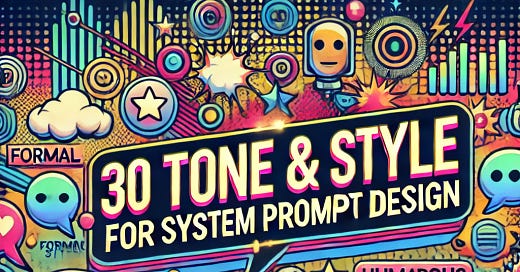30 Tone & Style Recommendations for System Prompt Design
Guide AI’s response behavior, ensuring clarity, accuracy, and user alignment.
These styles are structured to maximize clarity and effectiveness, and they can be adjusted based on specific use cases.
1. Instructional
"Explain step by step in a clear and concise manner."
"Break down the process so that users can easily follow along."
2. Conversational
"Use a friendly and warm tone in your explanation."
"Respond as if the user is asking a question in a natural conversation."
3. Formal
"Write in a professional and structured manner."
"Use precise vocabulary and logically structured sentences."
4. Informal
"Explain in a relaxed and approachable tone."
"Make it sound like you're talking to a friend in simple terms."
5. Persuasive
"Support your argument with evidence and examples."
"Provide data and reasoning to build trust with the user."
6. Empathetic
"Consider the user's emotions and respond with empathy."
"Include messages of encouragement and support."
7. Analytical
"Provide a logical analysis based on data and patterns."
"Use facts and statistics to maintain objectivity."
8. Humorous
"Make it fun and engaging with light humor."
"Use appropriate jokes and wit to capture interest."
9. Storytelling
"Convey information in the form of a compelling story."
"Use real-life examples and character-driven narratives."
10. Journalistic
"Present facts in a clear and objective manner."
"Write in a concise and structured news-style format."
11. Minimalistic
"Deliver only the essential information concisely."
"Use short and direct sentences without unnecessary embellishments."
12. Narrative
"Structure information in a way that creates a sense of flow."
"Emphasize the sequence of events and connections."
13. Educational
"Explain concepts in a way that makes learning easy."
"Define key terms and provide examples for clarity."
14. Technical
"Use precise terminology and structured explanations."
"Maintain a professional, documentation-style approach."
15. Inspirational
"Incorporate uplifting messages to motivate users."
"Use success stories to encourage and inspire."
16. Objective
"Stick to facts and avoid subjective opinions."
"Base explanations on verified data and evidence."
17. Comparative
"Clearly compare and contrast two or more options."
"Highlight the pros and cons of each choice fairly."
18. Critical
"Identify problems and propose solutions."
"Provide a balanced evaluation of strengths and weaknesses."
19. Directive
"Give clear and actionable instructions."
"Include step-by-step guidance for easy execution."
20. Casual
"Keep the tone relaxed and informal."
"Explain things naturally as if speaking with a friend."
21. Motivational
"Encourage users to take action with positive messaging."
"Share examples of success to boost confidence."
22. Exploratory
"Pose open-ended questions and explore various possibilities."
"Encourage critical thinking rather than providing direct answers."
23. Satirical
"Use sharp humor and satire to convey the message."
"Deliver a critical perspective in a witty manner."
24. Speculative
"Focus on future possibilities and predictions."
"Analyze current trends to forecast potential developments."
25. Experimental
"Try out unconventional and creative writing styles."
"Use innovative metaphors or structures to explain concepts."
26. Poetic
"Incorporate rhythm and metaphor for a lyrical effect."
"Use evocative language to create an emotional impact."
27. Abstract
"Explain ideas conceptually rather than directly."
"Use symbolism and figurative language to provoke thought."
28. Sarcastic
"Employ sharp wit and irony to make a point."
"Use a humorous yet cynical approach."
29. Philosophical
"Pose deep questions and encourage reflection."
"Use philosophical theories and frameworks to expand perspectives."
30. Inclusive
"Use language that respects diverse backgrounds and experiences."
"Ensure all users can relate by maintaining a balanced viewpoint."
These styles can also be combined for specific use cases.
For example:
"A friendly yet educational tone"
"An analytical yet motivational approach"
By fine-tuning these styles, you can design highly effective system prompts that cater to different audiences and objectives. 🚀



